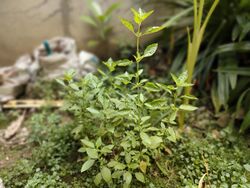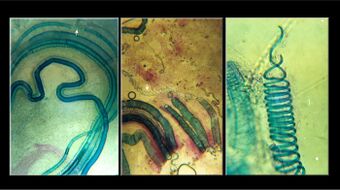Vascular plant
Topic: Biology
 From HandWiki - Reading time: 7 min
From HandWiki - Reading time: 7 min
| Vascular plants | |
|---|---|

| |
| Lemon basil, a seed-bearing plant | |
| Scientific classification | |
| Kingdom: | Plantae |
| Clade: | Embryophytes |
| Clade: | Polysporangiophytes |
| Clade: | Tracheophytes |
| Divisions † Extinct | |
| |
Vascular plants (from la vasculum 'duct'), or collectively the phylum Tracheophyta (/trəˈkiː.əfaɪtə/;[3][4] from grc τραχεῖα ἀρτηρία (trakheîa artēría) 'windpipe', and φυτά (phutá) 'plants'),[4] form a large group of land plants (c. 300,000 accepted known species)[5] that have lignified tissues (the xylem) for conducting water and minerals throughout the plant. They also have a specialized non-lignified tissue (the phloem) to conduct products of photosynthesis. Vascular plants include the clubmosses, horsetails, ferns, gymnosperms (including conifers), and angiosperms (flowering plants). Scientific names for the group include Tracheophyta,[6][7]:251 Tracheobionta[8] and Equisetopsida sensu lato. Some early land plants (the rhyniophytes) had less developed vascular tissue; the term eutracheophyte has been used for all other vascular plants, including all living ones.
Historically, vascular plants were known as "higher plants", as it was believed that they were further evolved than other plants due to being more complex organisms. However, this is an antiquated remnant of the obsolete scala naturae, and the term is generally considered to be unscientific.[9]
Characteristics
Botanists define vascular plants by three primary characteristics:
- Vascular plants have vascular tissues which distribute resources through the plant. Two kinds of vascular tissue occur in plants: xylem and phloem. Phloem and xylem are closely associated with one another and are typically located immediately adjacent to each other in the plant. The combination of one xylem and one phloem strand adjacent to each other is known as a vascular bundle.[10] The evolution of vascular tissue in plants allowed them to evolve to larger sizes than non-vascular plants, which lack these specialized conducting tissues and are thereby restricted to relatively small sizes.
- In vascular plants, the principal generation or phase is the sporophyte, which produces spores and is diploid (having two sets of chromosomes per cell). (By contrast, the principal generation phase in non-vascular plants is the gametophyte, which produces gametes and is haploid - with one set of chromosomes per cell.)
- Vascular plants have true roots, leaves, and stems, even if some groups have secondarily lost one or more of these traits.
Cavalier-Smith (1998) treated the Tracheophyta as a phylum or botanical division encompassing two of these characteristics defined by the Latin phrase "facies diploida xylem et phloem instructa" (diploid phase with xylem and phloem).[7]:251
One possible mechanism for the presumed evolution from emphasis on haploid generation to emphasis on diploid generation is the greater efficiency in spore dispersal with more complex diploid structures. Elaboration of the spore stalk enabled the production of more spores and the development of the ability to release them higher and to broadcast them farther. Such developments may include more photosynthetic area for the spore-bearing structure, the ability to grow independent roots, woody structure for support, and more branching.[citation needed]
Phylogeny
A proposed phylogeny of the vascular plants after Kenrick and Crane 1997[11] is as follows, with modification to the gymnosperms from Christenhusz et al. (2011a),[12] Pteridophyta from Smith et al.[13] and lycophytes and ferns by Christenhusz et al. (2011b) [14] The cladogram distinguishes the rhyniophytes from the "true" tracheophytes, the eutracheophytes.[11]
|
Lua error: Internal error: The interpreter exited with status 1. |
Gymnosperms |
This phylogeny is supported by several molecular studies.[13][15][16] Other researchers state that taking fossils into account leads to different conclusions, for example that the ferns (Pteridophyta) are not monophyletic.[17]
Hao and Xue presented an alternative phylogeny in 2013 for pre-euphyllophyte plants.[18]
|
Lua error: Internal error: The interpreter exited with status 1. |
Rhyniopsids
Renalioids |
Nutrient distribution

Water and nutrients in the form of inorganic solutes are drawn up from the soil by the roots and transported throughout the plant by the xylem. Organic compounds such as sucrose produced by photosynthesis in leaves are distributed by the phloem sieve-tube elements.
The xylem consists of vessels in flowering plants and of tracheids in other vascular plants. Xylem cells are dead hard-walled hollow cells arranged to form files of tubes that function in the transport of water. A tracheid cell-wall usually contains the polymer lignin.
The phloem, on the other hand, consists of living cells called sieve-tube members. Between the sieve-tube members are sieve plates, which have pores to allow molecules to pass through. Sieve-tube members lack such organs as nuclei or ribosomes, but cells next to them, the companion cells, function to keep the sieve-tube members alive.
Transpiration
The most abundant compound in all plants, as in all cellular organisms, is water, which has an important structural role and a vital role in plant metabolism. Transpiration is the main process of water movement within plant tissues. Plants constantly transpire water through their stomata to the atmosphere and replace that water with soil moisture taken up by their roots. The movement of water out of the leaf stomata sets up a transpiration pull or tension in the water-column in the xylem vessels or tracheids. The pull is the result of water surface tension within the cell walls of the mesophyll cells, from the surfaces of which evaporation takes place when the stomata are open. Hydrogen bonds exist between water molecules, causing them to line up; as the molecules at the top of the plant evaporate, each pulls the next one up to replace it, which in turn pulls on the next one in line. The draw of water upwards may be entirely passive and can be assisted by the movement of water into the roots via osmosis. Consequently, transpiration requires the plant to expend very little energy on water movement. Transpiration assists the plant in absorbing nutrients from the soil as soluble salts. Transpiration plays an important role in the absorption of nutrients from the soil as soluble salts are transported along with the water from the soil to the leaves. Plants can adjust their transpiration rate to optimize the balance between water loss and nutrient absorption.[19]
Absorption
Living root cells passively absorb water in the absence of transpiration pull via osmosis creating root pressure. It is possible for there to be no evapotranspiration and therefore no pull of water towards the shoots and leaves. This is usually due to high temperatures, high humidity, darkness or drought.Lua error: Internal error: The interpreter exited with status 1.
Conduction
Xylem is the water-conducting tissue, and secondary xylem provides the raw material for the forest products industry.[20]Xylem and phloem tissues each play a part in the conduction processes within plants. Sugars are conducted throughout the plant in the phloem; water and other nutrients through the xylem. Conduction occurs from a source to a sink for each separate nutrient. Sugars are produced in the leaves (a source) by photosynthesis and transported to the growing shoots and roots (sinks) for use in growth, cellular respiration or storage. Minerals are absorbed in the roots (a source) and transported to the shoots to allow cell division and growth.[21][22][23]
See also
References
- ↑ D. Edwards; Feehan, J. (1980). "Records of Cooksonia-type sporangia from late Wenlock strata in Ireland". Nature 287 (5777): 41–42. doi:10.1038/287041a0. Bibcode: 1980Natur.287...41E.
- ↑ Lua error: Internal error: The interpreter exited with status 1.
- ↑ "vascular plant | Definition, Characteristics, Taxonomy, Examples, & Facts". https://www.britannica.com/plant/tracheophyte.
- ↑ 4.0 4.1 "Tracheophyta – an overview". https://www.sciencedirect.com/topics/agricultural-and-biological-sciences/tracheophyta#:~:text=The%20vascular%20plants,%20or%20Tracheophyta,(excluding%20many%20fossil%20groups)..
- ↑ Christenhusz, M. J. M.; Byng, J. W. (2016). "The number of known plants species in the world and its annual increase". Phytotaxa 261 (3): 201–217. doi:10.11646/phytotaxa.261.3.1. http://biotaxa.org/Phytotaxa/article/download/phytotaxa.261.3.1/20598.
- ↑ Abercrombie, Michael; Hickman, C. J.; Johnson, M. L. (1966). A Dictionary of Biology. Penguin Books.
- ↑ 7.0 7.1 Cite error: Invalid
<ref>tag; no text was provided for refs namedcav - ↑ "ITIS Standard Report Page: Tracheobionta". https://www.itis.gov/servlet/SingleRpt/SingleRpt?search_topic=TSN&search_value=564824.
- ↑ "Vascular Plants: Definition, Classification, Characteristics & Examples". https://sciencing.com/vascular-plants-13719225.html.
- ↑ "Xylem and Phloem". 26 August 2020. https://basicbiology.net/plants/physiology/xylem-phloem.
- ↑ 11.0 11.1 Kenrick, Paul; Crane, Peter R. (1997). The Origin and Early Diversification of Land Plants: A Cladistic Study. Washington, D.C.: Smithsonian Institution Press. ISBN 1-56098-730-8.
- ↑ Christenhusz, Maarten J. M.; Reveal, James L.; Farjon, Aljos; Gardner, Martin F.; Mill, R.R.; Chase, Mark W. (2011). "A new classification and linear sequence of extant gymnosperms". Phytotaxa 19: 55–70. doi:10.11646/phytotaxa.19.1.3. http://www.mapress.com/phytotaxa/content/2011/f/pt00019p070.pdf.
- ↑ 13.0 13.1 Smith, Alan R.; Pryer, Kathleen M.; Schuettpelz, E.; Korall, P.; Schneider, H.; Wolf, Paul G. (2006). "A classification for extant ferns". Taxon 55 (3): 705–731. doi:10.2307/25065646. http://www.pryerlab.net/publication/fichier749.pdf.
- ↑ Christenhusz, Maarten J. M.; Zhang, Xian-Chun; Schneider, Harald (2011). "A linear sequence of extant families and genera of lycophytes and ferns". Phytotaxa 19: 7–54. doi:10.11646/phytotaxa.19.1.2. http://www.mapress.com/phytotaxa/content/2011/f/pt00019p054.pdf.
- ↑ Pryer, K. M.; Schneider, H.; Smith, A. R.; Cranfill, R.; Wolf, P. G.; Hunt, J. S.; Sipes, S. D. (2001). "Horsetails and ferns are a monophyletic group and the closest living relatives to seed plants". Nature 409 (6820): 618–22. doi:10.1038/35054555. PMID 11214320. Bibcode: 2001Natur.409..618S.
- ↑ Pryer, K. M.; Schuettpelz, E.; Wolf, P. G.; Schneider, H.; Smith, A. R.; Cranfill, R. (2004). "Phylogeny and evolution of ferns (monilophytes) with a focus on the early leptosporangiate divergences". American Journal of Botany 91 (10): 1582–1598. doi:10.3732/ajb.91.10.1582. PMID 21652310.
- ↑ Rothwell, G. W.; Nixon, K. C. (2006). "How Does the Inclusion of Fossil Data Change Our Conclusions about the Phylogenetic History of Euphyllophytes?". International Journal of Plant Sciences 167 (3): 737–749. doi:10.1086/503298.
- ↑ Hao, Shougang; Xue, Jinzhuang (2013), The early Devonian Posongchong flora of Yunnan: a contribution to an understanding of the evolution and early diversification of vascular plants, Beijing: Science Press, pp. 366, ISBN 978-7-03-036616-0, https://www.researchgate.net/publication/269875285, retrieved 2019-10-25
- ↑ Raven, J. A.; Edwards, D. (2001-03-01). "Roots: evolutionary origins and biogeochemical significance" (in en). Journal of Experimental Botany 52 (suppl 1): 381–401. doi:10.1093/jexbot/52.suppl_1.381. ISSN 0022-0957. PMID 11326045. https://academic.oup.com/jxb/article-lookup/doi/10.1093/jexbot/52.suppl_1.381.
- ↑ Zhao, Chengsong; Craig, Johanna C.; Petzold, H. Earl; Dickerman, Allan W.; Beers, Eric P. (2005-06-01). "The Xylem and Phloem Transcriptomes from Secondary Tissues of the Arabidopsis Root-Hypocotyl" (in en). Plant Physiology 138 (2): 803–818. doi:10.1104/pp.105.060202. ISSN 1532-2548. PMID 15923329.
- ↑ Taiz, Lincoln; Zeiger, Eduardo (2002). "5, 6, 10". Plant Physiology (3 ed.). Sunderland, Massachusetts: Sinauer Associates.
- ↑ Doyle, James A. (1998). "Phylogeny of Vascular Plants" (in en). Annual Review of Ecology and Systematics 29 (1): 567–599. doi:10.1146/annurev.ecolsys.29.1.567. ISSN 0066-4162. https://www.annualreviews.org/doi/10.1146/annurev.ecolsys.29.1.567.
- ↑ Heijmans, Monique M. P. D.; Arp, Wim J.; Berendse, Frank (October 2001). "Effects of elevated CO 2 and vascular plants on evapotranspiration in bog vegetation: EVAPOTRANSPIRATION IN BOG VEGETATION" (in en). Global Change Biology 7 (7): 817–827. doi:10.1046/j.1354-1013.2001.00440.x. http://doi.wiley.com/10.1046/j.1354-1013.2001.00440.x.
Lua error: Internal error: The interpreter exited with status 1.
Bibliography
- Assembling the Tree of Life. Oxford University Press. 2004. ISBN 978-0-19-972960-9. https://books.google.com/books?id=6lXTP0YU6_kC.
- Cantino, Philip D.; Doyle, James A.; Graham, Sean W.; Judd, Walter S.; Olmstead, Richard G.; Soltis, Douglas E.; Soltis, Pamela S.; Donoghue, Michael J. (1 August 2007). "Towards a Phylogenetic Nomenclature of Tracheophyta". Taxon 56 (3): 822. doi:10.2307/25065865.
- Kenrick, P. (29 June 2000). "The relationships of vascular plants". Philosophical Transactions of the Royal Society B: Biological Sciences 355 (1398): 847–855. doi:10.1098/rstb.2000.0619. PMID 10905613.
- Pryer, Kathleen M.; Schneider, Harald; Magallon, Susana. The radiation of vascular plants. pp. 138–153. http://pryerlab.biology.duke.edu/uploads/media_items/pryer-et-al-tol-2004.original.pdf., in (Cracraft Donoghue )
External links
Lua error: Internal error: The interpreter exited with status 1. Lua error: Internal error: The interpreter exited with status 1. Wikidata ☰ Q27133 entry
Lua error: Internal error: The interpreter exited with status 1.
 KSF
KSF